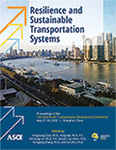13th Asia Pacific Transportation Development Conference
Research on Co-Simulation Modelling and Anti-Skid Control for Rolling Stock Braking System
Publication: Resilience and Sustainable Transportation Systems
ABSTRACT
Control performance of rolling system has important influence on safety transport operation on stock braking, especially braking anti-skid control performance in the state of low adhesion. Aimed at current computerized direct acting electro-pneumatic braking system, creep model between wheel and rail, braking dynamics model, pneumatic braking unit, and anti-skid control model is established in this paper. By using simulation interface with each other between MATLAB/Simulink and AMESim, co-simulation platform for braking anti-skid control system is built up, and the effectiveness of the platform is verified through comparing simulation data with experimental data. Simulation analysis is carried out for typical slide conditions with various adhesive constraints and different initial braking speed, control performance of threshold value of many anti-skid criterions was studied, and discussed through analyzing simulation results by means of braking distance, braking time, and adhesive utilization, and verified by HIL (hardware-in-loop) simulation. The results show that the co-simulation platform can be used to simulate the sliding conditions in the braking process, and to optimize the criterion parameters of braking anti-skid control stagey.
Get full access to this article
View all available purchase options and get full access to this chapter.
REFERENCE
1.
Chen Wei, Zhou Jun, Wang Xinhai, et al. Theory and test of braking and anti-skid control for Hexie EMU[J]. Railway Locomotive & Car, 2011(5):32-38.
2.
Suh, M W, Park, Y K, Kwons, J. Braking performances simulation for a tractor-semitrailer vehicle with an air brake system[J]. Journal of Automobile Engineering, 2002, 216(1):43-51.
3.
Chol, J J, Park, S H, Kim, J S. Dynamic adhesion model and adaptive sliding mode brake control system for the railway rolling stocks[J]. Journal of Rail and Rapid Transit, 2007, 221(3):313-322.
4.
D. Frylmark, S. Johnsson. Automatic slip control for railway vehicles[D]. Linköping, Sweden: Linköpings Universitet, 2003.
5.
Maksym Spiryagin, Kwan Soo Lee, Hong Hee Yoo. Control system for maximum use of adhesive forces of a railway vehicle in a tractive mode[J]. Mechanical Systems and Signal Processing, 2008, 22(3):709-720.
6.
Hiroo YAMAZAKI, Masao NAGAI, Takayoshi KAMADA. A Study of Adhesion Force Model for Wheel Slip Prevention Control[C]. JSME International Journal, 2004,47(2):496-501.
7.
Chen Zheming, Zeng Jing, Luo Ren. Antiskid control and Simulation of train air braking [J]. Journal of The China Railway Society, 2009(4): 25-31.
8.
Luo Ren, Zeng Jing. Simulation of antiskid control of railway vehicles [J]. Journal of Mechanical Engineering, 2008(3): 29-34.
9.
Zuo Jianyong, Ren Lihui, Wu Mengling. Simulation and Experimental Research on antiskid control of railway vehicle braking system [J]. Journal of Tongji University, 2010, 38(6):912-916.
10.
Wu Mengling, Jiang Jingguo. Study on braking system scheme of high-speed EMUs in China [J]. Railway vehicles, 1999(4): 12-15.
11.
Li peishu, Liu Zhuanhua. Discussion on technology of imported braking system of high speed train [J]. Railway vehicles, 2004, 42(5):29-33.
12.
Deng Zhiming. Discussion on brake system design of high speed train [J]. Railway vehicles, 2006, 44(11): 15-20.
13.
Diao Feng, Zhu Wenliang, Qin Lingguang, Wu Mengling. Modeling, simulation and verification of antiskid control of rail transit vehicles based on finite state machine [J]. Urban Mass Transit, 2019,22(01):55-59.
14.
Polach, O. A Fast Wheel-Rail Forces Calculation Computer Code[J]. Vehicle System Dynamics, 2000, 33(Supplement): 728-739.
15.
Polach, O. Creep forces in simulations of traction vehicles running on adhesion limit[J]. Wear, 2005, 258(7-8): 992-1000.
16.
Hu zhunqing. EMU braking system. Beijing: Beijing Jiaotong University Press, 2012.
17.
Zhu Wenliang, Wu Mengling, Tian Chun, et al. Integrated simulation platform of railway vehicle braking system based on multidisciplinary collaborative analysis [J]. Journal of Traffic and Transportation Engineering, 2017, 17(03): 99-110.
Information & Authors
Information
Published In
Resilience and Sustainable Transportation Systems
Pages: 97 - 108
Editors: Fengxiang Qiao, Ph.D., Texas Southern University, Yong Bai, Ph.D., Marquette University, Pei-Sung Lin, Ph.D., University of South Florida, Steven I Jy Chien, Ph.D., New Jersey Institute of Technology, Yongping Zhang, Ph.D., California State Polytechnic University, and Lin Zhu, Ph.D., Shanghai University of Engineering Science
ISBN (Online): 978-0-7844-8290-2
Copyright
© 2020 American Society of Civil Engineers.
History
Published online: Jun 29, 2020
Published in print: Jun 29, 2020
Authors
Metrics & Citations
Metrics
Citations
Download citation
If you have the appropriate software installed, you can download article citation data to the citation manager of your choice. Simply select your manager software from the list below and click Download.
